Gaming Mouse Weight Debate: Finding the Right Balance for Gamers
Updated On: November 13, 2025 by Aaron Connolly
Understanding the Gaming Mouse Weight Debate
Mouse weight changes how quickly you move, how well you aim, and how long you can play before your hand gets tired.
Gamers can’t agree on the best weight—some swear by ultra-light mice under 70g, while others stick to heavier models above 100g.
Why Mouse Weight Matters in Gaming
Your gaming mouse’s weight affects three big things: response time, precision, and fatigue.
With a lighter mouse, you barely need to push to start or stop moving, so your reactions get faster in those high-pressure moments.
Precision shifts with weight, too.
Light mice make flick shots and fast sweeps easier, while heavier ones help you track targets smoothly and nail steady aim.
Fatigue sneaks up on you depending on your mouse weight.
Pro esports players often deal with muscle strain during long hours, but lighter mice can cut forearm muscle activity by up to 15%.
Your grip style plays a role here.
Claw grip users usually lean toward lighter mice for those quick wrist flicks, while palm grip gamers like the stability from a bit of extra heft.
Game genre? Yeah, that matters.
Shooters like Counter-Strike work best with lighter mice for fast target switches, but strategy games benefit from heavier models for careful unit selection and map movement.
Common Misconceptions About Mouse Weight
Some folks think lighter mice will instantly make them better players.
That just isn’t true for everyone.
Pros use everything from 45g featherweights to chunky 120g mice, depending on what fits their style.
People love to say, “Heavier mice are outdated,” but that’s not really the case.
Modern heavy mice use top-tier sensors and slick materials.
Weight doesn’t decide sensor quality or how well your mouse tracks.
There’s no universal answer here.
Hand size, grip strength, and your posture all affect which mouse feels right.
What works for a streamer might not fit your hand at all.
Don’t believe that “price equals performance” either.
Just because a mouse costs more or weighs less doesn’t mean it’s better.
Sensor accuracy and build quality matter way more than just the number on the scale.
Some players also think weight changes how the sensor works.
That’s just not true—modern sensors perform the same in both light and heavy mice.
History of the Weight Debate
Back in the early 2000s, gaming mice weighed 120-150g, mostly because of ball tracking and chunky parts.
Gamers didn’t have much choice, so everyone just used what was available.
By 2005, optical sensors showed up and let companies like Logitech and Razer start making lighter mice.
Forum debates about mouse weight started as soon as sub-100g models hit the shelves.
Around 2018, Fortnite pros drilled holes in their mice to make them lighter.
Brands caught on and launched official models under 70g.
Competitive gaming pushed weights even lower.
Pro players started winning tournaments with ultra-light mice, and sponsors sent out custom gear to their teams.
Now, gaming mice range from 45g to 120g.
Fans of every weight category claim their choice is best.
New materials and designs keep pushing weights lower, but durability is still a concern.
Not everyone wants a featherweight mouse, though.
Some gamers prefer heavier models for control and stability, which created a market for balanced options in the 80-100g range.
Lightweight Mice: Pros and Cons
Lightweight mice usually come in at 80 grams or less, while older gaming mice often tip the scale at over 100 grams.
They’re super fast and easy on your hand, but they’re not perfect for everyone.
Advantages of Using a Lightweight Mouse
Faster flick shots pull in competitive players.
With less mass to move, you can lift and stop your mouse right where you want.
This really matters in FPS games and MOBAs where split-second moves decide the winner.
Your wrist and arm thank you after long gaming sessions.
Moving 60 grams around all night is way easier on your muscles than shifting a heavy 120-gram mouse.
Most people notice the difference after just a few hours.
Direction changes get easier, too.
With less inertia, your crosshair follows your hand more closely.
You don’t have to fight against the mouse’s weight to make quick corrections.
Mice like the Glorious Model O use honeycomb shells to keep things light.
Those holes also let your palm breathe during sweaty matches.
Drawbacks and Potential Downsides
Switching from a heavy mouse to a light one takes some getting used to.
At first, you might overshoot your targets because you expect more resistance.
Give it at least a couple of weeks to really adjust.
Ultra-light designs can have durability issues.
The honeycomb holes let in dust and debris, and thin plastic shells sometimes crack if you get rough.
Build quality isn’t always consistent.
Some budget lightweight mice feel flimsy, so it’s smart to read reviews before buying.
If you have big hands, lightweight mice might feel too small.
That can lead to cramping if the mouse doesn’t fill your palm.
Popular Lightweight Mouse Models
The Glorious Model O is a fan favorite at about 67 grams.
Its honeycomb design and matte finish make it grippy and affordable.
The wireless version adds just a couple of grams.
SteelSeries has the Aerox series, starting around £60, with both wired and wireless models under 70 grams.
Finalmouse built a following with ultra-light designs, though they’re tough to find and pricey.
Their mice often weigh under 60 grams.
Razer’s Viper Ultimate clocks in at 74 grams and comes with wireless charging.
It’s more expensive but feels solid and has flashy RGB lighting.
Quick tip: Try a lightweight mouse in person if you can.
Specs only tell part of the story—your hand shape and grip matter more.
Heavyweight Mice: Pros and Cons
Heavy gaming mice—usually over 100 grams—offer a sense of stability and control that some players won’t give up.
But they have their own downsides, especially if you play for hours at a time.
Benefits of Heavy Gaming Mice
Heavy mice give you more stability.
That extra weight cuts down on shaky movements that can mess up your aim, especially on high sensitivity.
When you crank up your sensitivity, even tiny hand twitches can send your crosshair flying.
A heavy mouse steadies things and keeps those movements in check.
The extra mass helps your mouse stay in contact with the pad.
You get fewer skips or tracking hiccups during fast swipes.
Fine, detailed work feels easier with heavy mice.
The resistance helps with those small, careful adjustments.
Bigger mice also fit large hands better.
If your hands are on the bigger side, a heavy mouse often feels more comfortable and natural to grip.
Limitations and User Challenges
The big downside? Heavy mice tire you out faster.
Your arm muscles have to work harder to move and lift them, and that adds up during long sessions.
Players who use low sensitivity really notice this.
You have to make big arm movements to turn quickly, and lifting a 120g mouse over and over gets old fast.
Heavy mice can slow your reaction time.
It just takes more effort to start and stop, so flick shots and quick switches don’t come as easily.
Fast-paced games like Counter-Strike or Valorant need rapid crosshair changes.
Heavy mice make those moves feel slower and more forced.
Most pros have moved away from heavy mice.
Only about 8% of them still use models over 100g, while 72% now prefer mice under 80g.
Impact of Mouse Weight on Gaming Performance
Mouse weight shapes your reaction time, aim, and comfort in competitive games.
Lighter mice help you move faster and stay fresh, while heavier ones can steady your aim for tricky shots.
Speed and Agility in Fast-Paced Games
Lightweight mice (60-80g) give you a real edge in fast shooters like Counter-Strike or Valorant.
Your hand glides across the pad with less effort.
Pros pick ultra-light mice to flick between targets quicker.
Less mass means you don’t need as much force to change direction.
Mouse movement patterns shift with weight.
Heavy mice need more muscle to get going and more effort to stop right on target.
In games where you whip around 180 degrees, every gram matters.
Studies show lighter mice shave milliseconds off your reaction time for these quick turns.
Mouse makers now roll out ultra-light models just for competitive play.
Many weigh under 70g, a big drop from the 100g+ mice of the past.
Your muscle memory adapts to your mouse weight.
Switching between heavy and light mice can mess with your aim until you get used to it.
Control and Precision for Accuracy
Heavier mice (90-120g) can boost your precision in some situations.
That extra weight gives you resistance for small, careful adjustments.
Micro-corrections get easier with a bit of heft.
Your hand doesn’t overshoot as much, which helps with long-range shots.
Some pro snipers in games like CS2 actually prefer slightly heavier mice.
The stability helps them hold their crosshair steady when it counts.
Sensors work the same, no matter the mouse’s weight.
It’s your hand control and movement that change.
Weight balance is just as important as the number on the box.
A well-balanced 85g mouse can feel steadier than a lopsided 75g one.
Mouse movement gets more predictable with consistent weight.
Your brain learns how much force moves the cursor just right.
Fatigue and Endurance During Long Sessions
Long gaming sessions really highlight the difference between light and heavy mice.
Your muscle memory includes how tired your hand gets, not just how you aim.
Studies with esports pros show muscle activity jumps with heavier mice.
Your forearm works harder the longer you play.
Lightweight mice ease the strain on your wrist and fingers.
That’s a big deal during tournaments that last six to eight hours a day.
Mouse weight affects each grip style differently:
- Fingertip grip: Works best with ultra-light mice
- Palm grip: Handles moderate weight fine
- Claw grip: Likes light-to-medium weight
Super light mice can make you over-adjust at first.
Your hand might fly too far because it’s used to more resistance.
Pros say they feel less hand fatigue and play more consistently in tournaments when they pick a mouse weight that matches their grip.
Mouse Sensitivity and Its Relationship to Weight
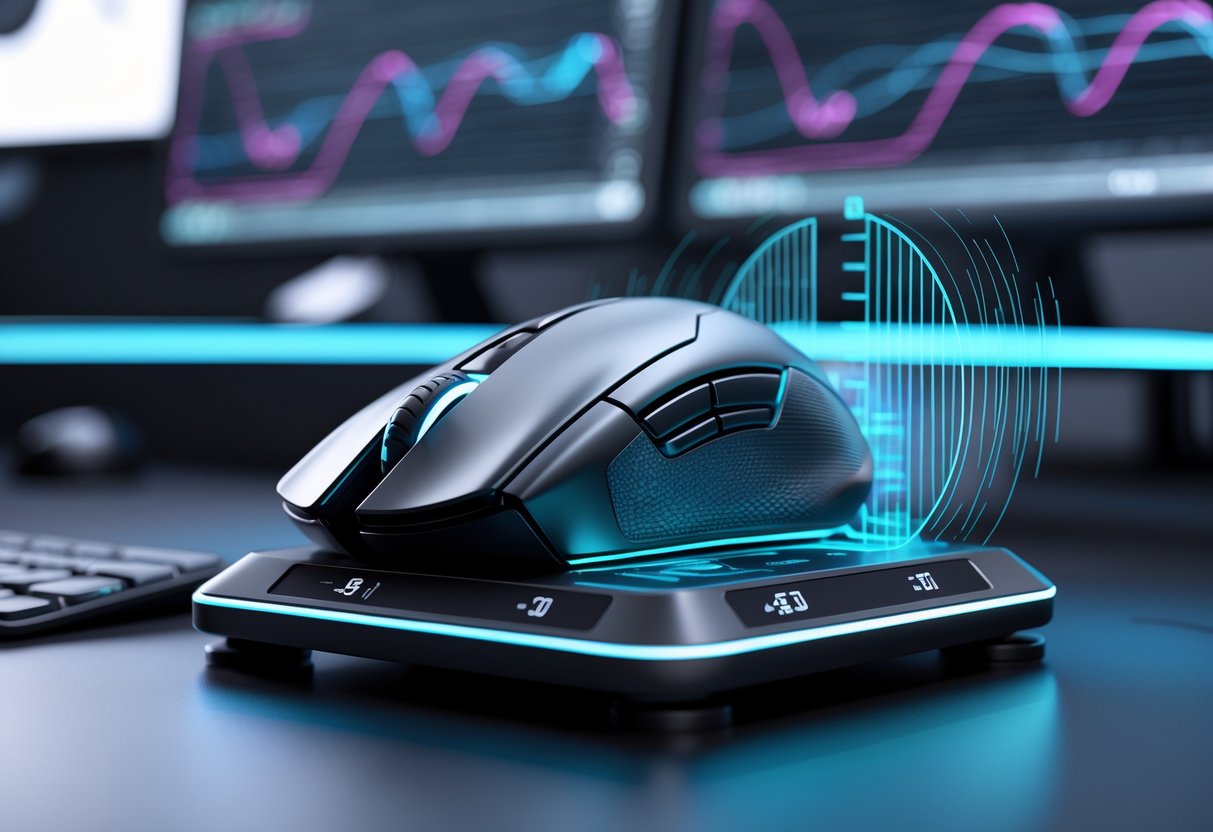
When you grab a lighter gaming mouse, you’ll probably want to tweak your sensitivity settings.
Physics really does change how your cursor feels.
Drop 15 grams, and suddenly your mouse feels way faster at the same DPI.
You’ll need to recalibrate if you want your aim to stay on point.
Adjusting DPI Settings for Different Weights
Mouse weight and DPI settings connect in some pretty straightforward ways. If you think back to physics class—force equals mass times acceleration—a lighter mouse just moves faster with the same hand flick.
Here’s how I usually tweak things:
- 10-15g lighter mouse: Drop your DPI by about 10-15%
- 20g+ lighter mouse: Try lowering DPI by 200-400 points
Pro gamers show this in action all the time. In competitive tests, players switching from an 87g mouse to an 80g one saw real changes in cursor speed even when they kept DPI the same.
Most gaming mice come with software for DPI adjustment. Start by reducing your DPI by the percentage of weight you lost, then tweak it as you play.
Quick tip: If your old mouse weighed 85g and your new one is 70g, you’ve got an 18% lighter mouse. Lower your DPI by about 18% to match.
Balancing Mouse Sensitivity and Weight
You’ll need to experiment with different combinations while gaming to find your sweet spot. Pro esports players sometimes spend weeks dialing in new gear, since even tiny changes can mess with muscle memory.
Weight categories and common DPI ranges:
- Ultra-light (60-70g): 400-1200 DPI
- Light (70-85g): 800-1600 DPI
- Medium (85-100g): 1200-2000+ DPI
Your grip style also makes a difference. Palm grip users usually go for heavier mice with higher DPI, while fingertip grip fans like lighter mice and lower DPI for more control.
Test out sensitivity tweaks in aim trainers before you jump into ranked matches. Lots of players notice that lighter mice need lower in-game sensitivity multipliers, not just a DPI change.
Heads up: Don’t mess with both weight and DPI at the same time. Change one thing, then train, or you’ll just confuse your aim.
Effect of Grip Styles on Mouse Weight Preference
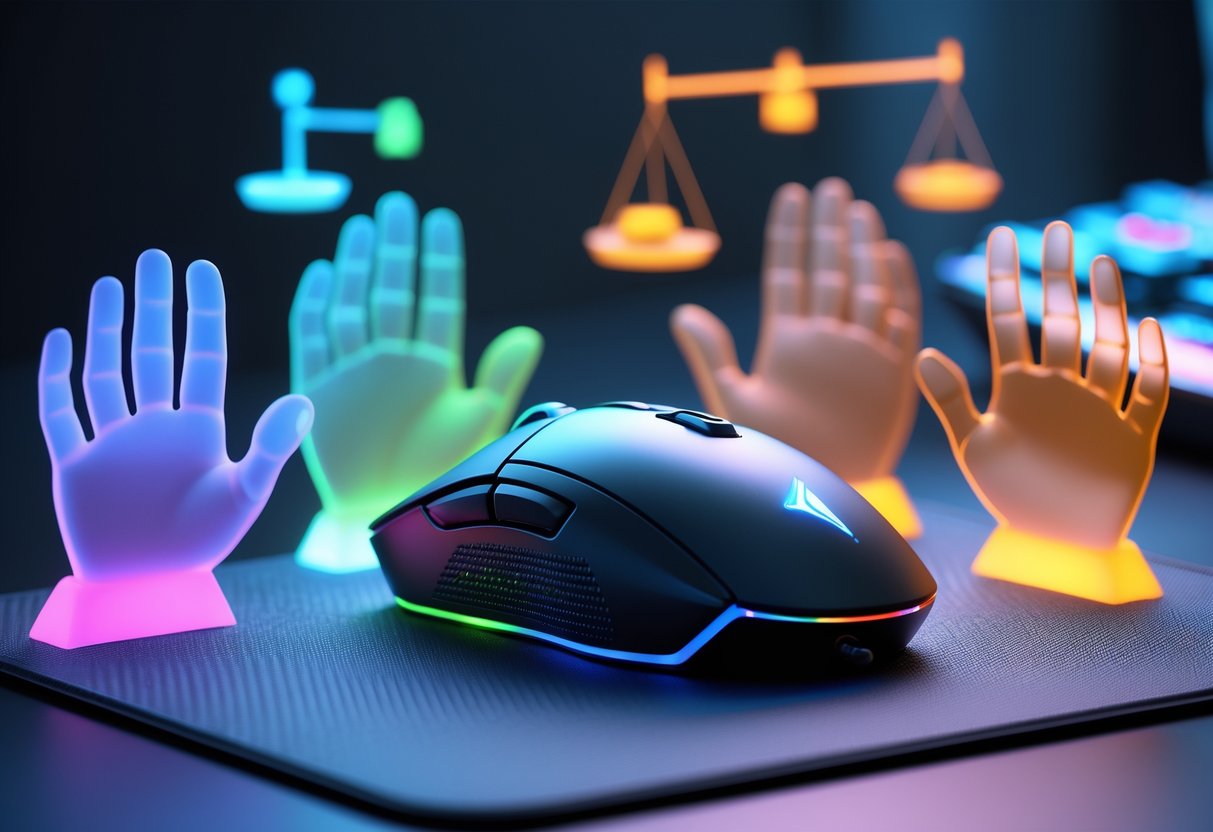
The way you grip your mouse totally changes which weight feels best and performs well. Palm grip users usually want heavier mice for stability. Claw grip players often look for something in the middle, and fingertip grip gamers love super light mice for fast movement.
Palm Grip and Mouse Weight
Palm grip players rest their whole hand on the mouse, so there’s lots of contact with the device. This grip just naturally makes heavier mice feel more comfortable, since your whole hand helps carry the weight.
Heavier mice pair nicely with palm grip because they keep things steady. That extra weight cuts down on accidental jitters when your palm’s covering the mouse.
Most palm grip fans stick with mice in the 100-120+ gram range. That weight just feels right because it spreads out across your palm, fingers, and wrist.
MMO and strategy gamers get a lot from this stability. These games demand careful cursor moves for all those abilities and unit commands.
Palm grip plus heavier mice means:
- Less hand fatigue in long sessions
- More stability for accurate moves
- A comfy, natural hand position
- Fewer accidental cursor jumps
Claw Grip: Stability Versus Agility
Claw grip sits between fingertip control and palm support. Your palm touches the back of the mouse, and your fingers arch up like a claw.
This style works best with mid-weight mice, usually 85-100 grams. You get enough stability for precision, but you don’t lose out on the quick movements claw grip can give.
Claw grip is super versatile. MOBA and RTS players like it because it lets you click accurately and move fast across the map.
With your fingers arched, you’re controlling things with both your fingertips and your palm. Mid-weight mice just seem to complement that balance.
What’s good about claw grip and mid-weight mice:
- Nice mix of precision and speed
- Comfortable even if you’re gaming for hours
- Fits lots of game genres
- Less strain on your fingers
Fingertip Grip and Lighter Mice
Fingertip grip means just your fingertips touch the mouse—your palm stays off. You need a lighter mouse here, since your fingers do all the lifting.
Ultra-light mice under 80 grams are the go-to for fingertip grip. In fact, a lot of top FPS players using this grip stick to mice in the 50-70g range for super quick response.
With no palm support, your fingers handle everything. Heavier mice just tire them out and slow down those snappy flicks.
Fingertip grip really shines for rapid direction changes in fast shooters. The lighter mouse moves instantly with your hand—no wrestling with inertia.
Why fingertip grip and light mice work:
- Instant reaction to every movement
- Almost no resistance during flicks
- Less finger fatigue, even after a long session
- Maximum agility for competitive play
Mouse Sensor Technology and Weight Considerations
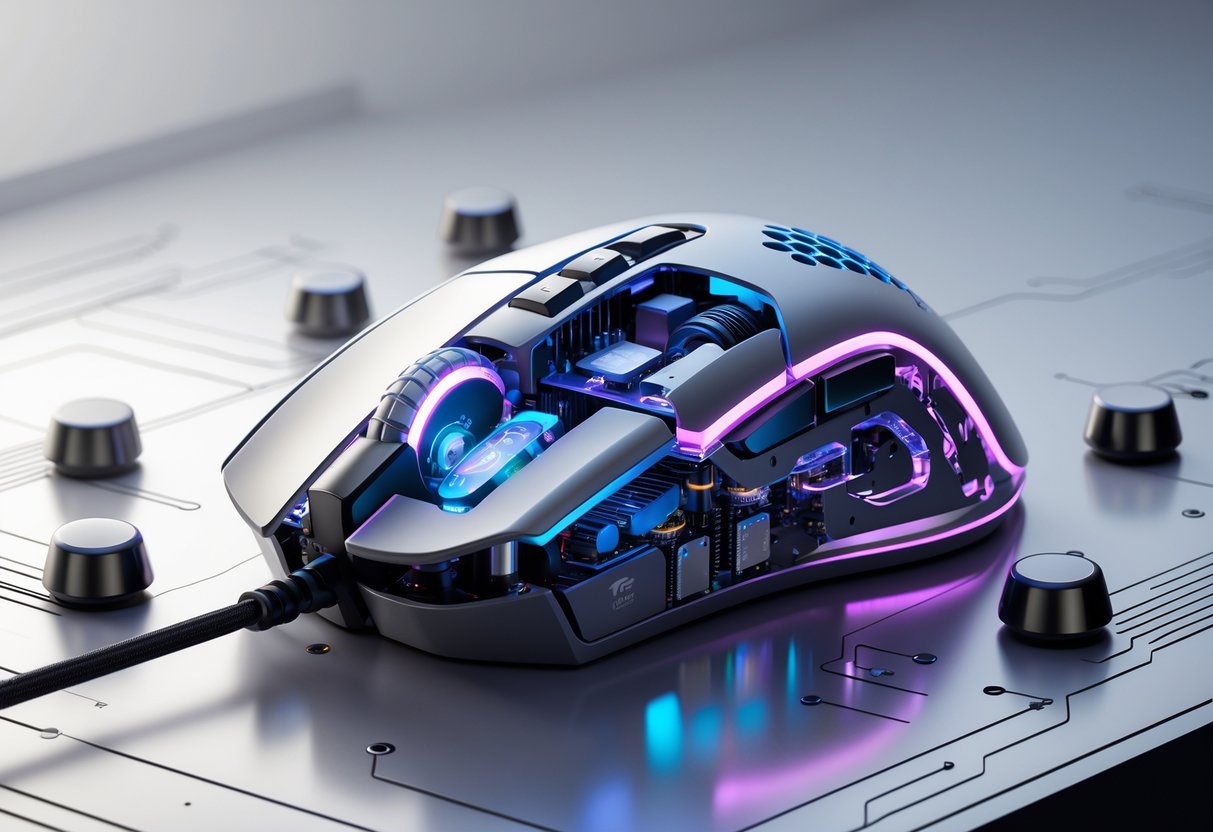
Gaming mouse sensors behave differently depending on weight, which can change how well they track. Lighter mice sometimes run into tracking problems during fast moves, while heavier mice feel steadier but take more effort to move precisely.
Sensor Performance in Lightweight Designs
Mice between 60-80 grams can sometimes push sensors to their limits, especially when you’re flicking fast or changing direction suddenly. Less weight means less stability.
Some common sensor hiccups in lightweight mice:
- Lift-off distance issues during big swipes
- Tracking errors on cloth pads
- Weird readings when you accelerate quickly
Modern optical sensors usually keep up, but you should still check the maximum tracking speed before buying.
Pro gamers still love lightweight mice, even with these quirks. For many, lower fatigue over long sessions is worth the occasional sensor blip.
Specs to check:
- Max tracking speed (inches per second)
- Max acceleration (G-force)
- Lift-off distance options
Sensor Accuracy in Heavier Mice
Mice weighing 90-130 grams give sensors a steadier ride for precise moves. That extra heft helps keep the mouse flat on the pad.
Heavier mice help sensors by:
- Giving you more stable tracking when you move slowly
- Cutting down on jitter at high DPI
- Performing better on glass or hard pads
Some research suggests 130g mice deliver the most consistent sensor results. The weight stops those tiny, unwanted shakes that can mess up accuracy in tactical games.
But heavier mice also mean your wrist and arm work harder. After long sessions, you might feel the burn, which can actually hurt your performance even if your tracking’s better.
Best weight ranges by game:
- FPS: 80-100 grams
- Strategy: 100-130 grams
- MOBA: 85-110 grams
Personal Preference Versus Game Genre Demands

Your style matters, but certain games force you to adapt. Fast shooters reward quick flicks. Strategy games? You want slow, steady control.
FPS and MOBA Genres: Lighter Versus Heavier Mice
First-person shooters need you to react in a split second. A light mouse under 80g makes those flick shots in Valorant or CS2 way easier.
Less weight means you can start and stop the mouse with barely any effort. Most pro FPS players stick to 60-80g for that reason.
MOBA games like League of Legends fall in the middle. You need to last-hit minions accurately, but also move quickly in team fights.
Most MOBA pros go for 80-100g mice. That’s a nice compromise between speed and control.
Quick test: Use your mouse in an aim trainer. After 30 minutes, see if your aim drops off from fatigue.
Strategy and MMO: Stability or Speed?
Strategy games want accuracy over speed. In titles like StarCraft II, you need to pick out small units and place buildings precisely.
Heavier mice (100-120g) give you the stability for those careful moves. The extra weight helps stop you from overshooting your targets.
MMORPGs like WoW mean long play sessions. A heavier mouse can reduce hand tremors during those marathon raids.
Don’t go overboard: If your mouse is heavier than 130g, you’ll probably just tire out your arm.
Strategy players often like adjustable weights. Add more for slow, careful base building; lighten up for fast combat.
Customisation: Adjustable Weights and Modularity
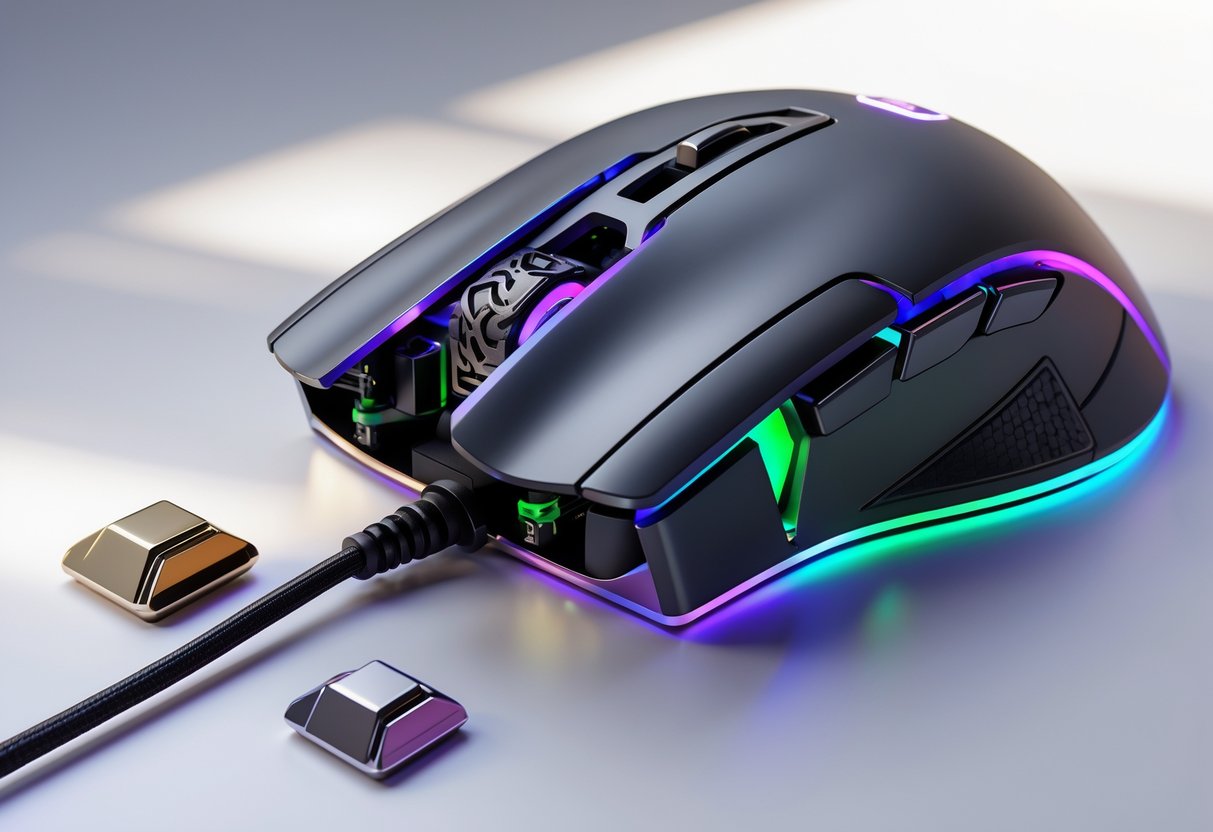
Modern gaming mice let you customise weight with removable inserts and modular parts. You can fine-tune the feel for better comfort and control during long sessions.
Benefits of Adjustable Weight Systems
Adjustable weights finally fix the “one size fits all” problem. You can pop in or pull out small metal weights to match your grip and game.
Comfort perks include less hand fatigue during long marathons. Palm grip players usually want a bit more heft, while fingertip grip folks go lighter for speed.
Performance-wise:
- FPS: Lighter (60-80g) for quick flicks
- Strategy: Heavier (100-120g) for steadier control
- MMORPG: Medium (80-100g) for balance
Where you put the weights matters, too. You can shift them to stop the mouse from drifting and help tracking.
Muscle memory gets more reliable when your mouse weight stays the same, even if you switch setups at home or at tournaments.
How to Customise Mouse Weight for Comfort
Start off with your mouse at its lightest—remove all the weights. Play for about 30 minutes to see how it feels.
Add weights one at a time:
- Put in a single weight (2-4g)
- Play for 15-20 minutes
- Pay attention to comfort and accuracy
- Repeat until it feels just right
Most mice with adjustable weights offer 5-10 inserts for a total of 15-30g of range. The Logitech G502 is a good example, letting you move weights around for balance.
Try different setups for each game you play. Jot down what works best for each genre.
Don’t make huge changes all at once. Big jumps in weight can throw off your muscle memory. Go slow.
Some brands even let you swap out shells and parts, not just weights. That way, you can change the shape and surface feel, too.
Transitioning Between Different Mouse Weights
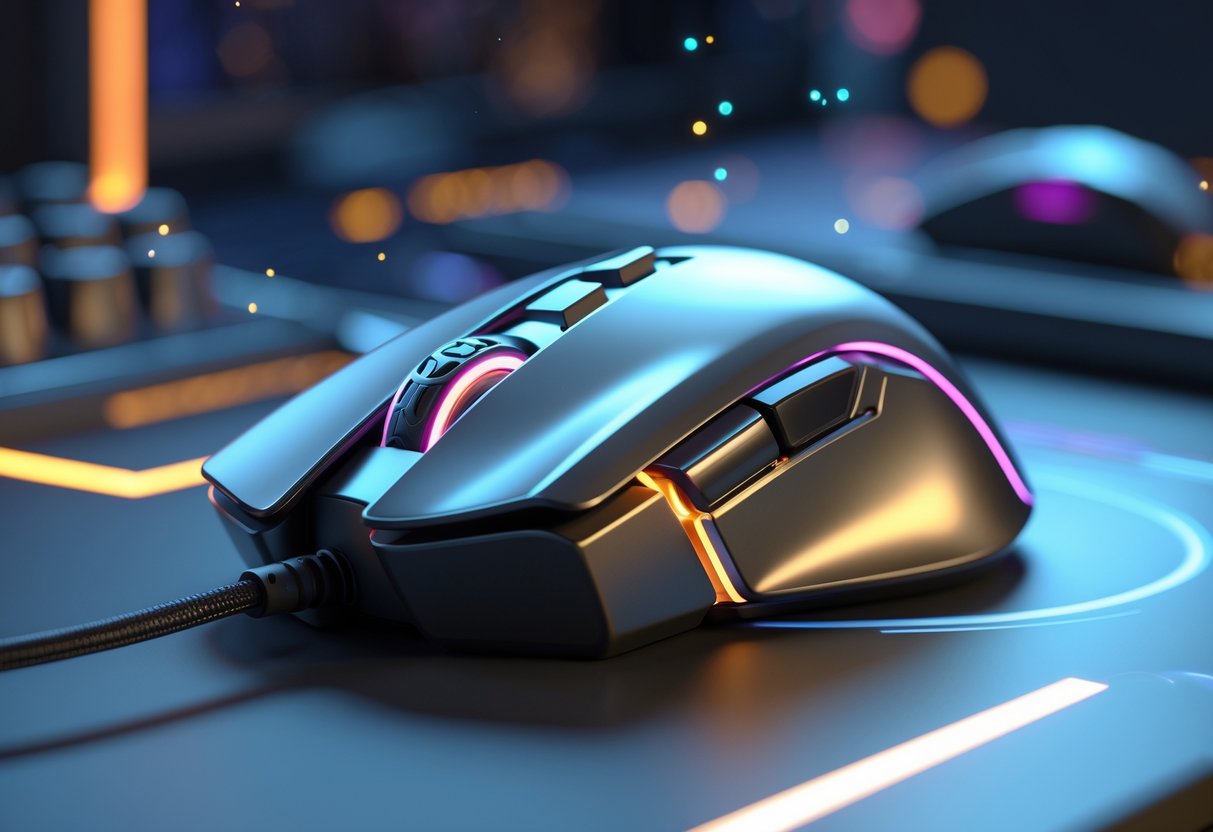
Switching mouse weights can mess with your aim and movement more than you might think. Your muscle memory needs a little time to catch up, but you can speed up the adjustment with the right approach.
Muscle Memory and Adaptation
Your muscle memory holds thousands of tiny movements from your current gaming mouse. When you change the weight, those patterns suddenly feel a bit off.
Lighter mice need less force to move the same distance. So, your flick shots might overshoot at first.
Heavier mice demand more effort for quick movements. You’ll probably notice your crosshair falling just short of your target.
Most gamers take about 1-2 weeks to get used to a new mouse weight. Some pro players admit they feel “off” for a few days after switching.
The adaptation period depends on a few things:
- Weight difference (the bigger the change, the longer it takes)
- Daily gaming hours (more practice helps you adapt faster)
- Game types (precision shooters take longer than strategy games)
Quick tip: Warm up with aim trainers before you dive into ranked games. Focused practice helps your muscle memory adjust quicker.
Tips for Switching Weights Successfully
Start by adjusting your sensitivity settings. Lighter mice often need lower sensitivity to keep your control consistent.
Here’s a simple trick: If your new mouse is 15g lighter, drop your DPI by about 10-15%. Jump into a game and see how it feels, then tweak as needed.
Practice specific movements every day:
-
Target switching drills
-
180-degree turns
-
Small tracking movements
-
Flick shots at different distances
Don’t mess with multiple settings at once. Stick to your new weight for at least a week before changing anything else.
Use aim training software like Kovaak’s or Aim Lab for 15-20 minutes before each session. Aim for consistency first—speed will come with time.
Warning: Don’t keep switching between different mice while you’re adapting. That just resets your muscle memory and makes it harder to settle in.
Many semi-pros suggest keeping a practice log. Write down which movements feel smooth and which ones need more work.
Durability and Build Quality in Relation to Weight
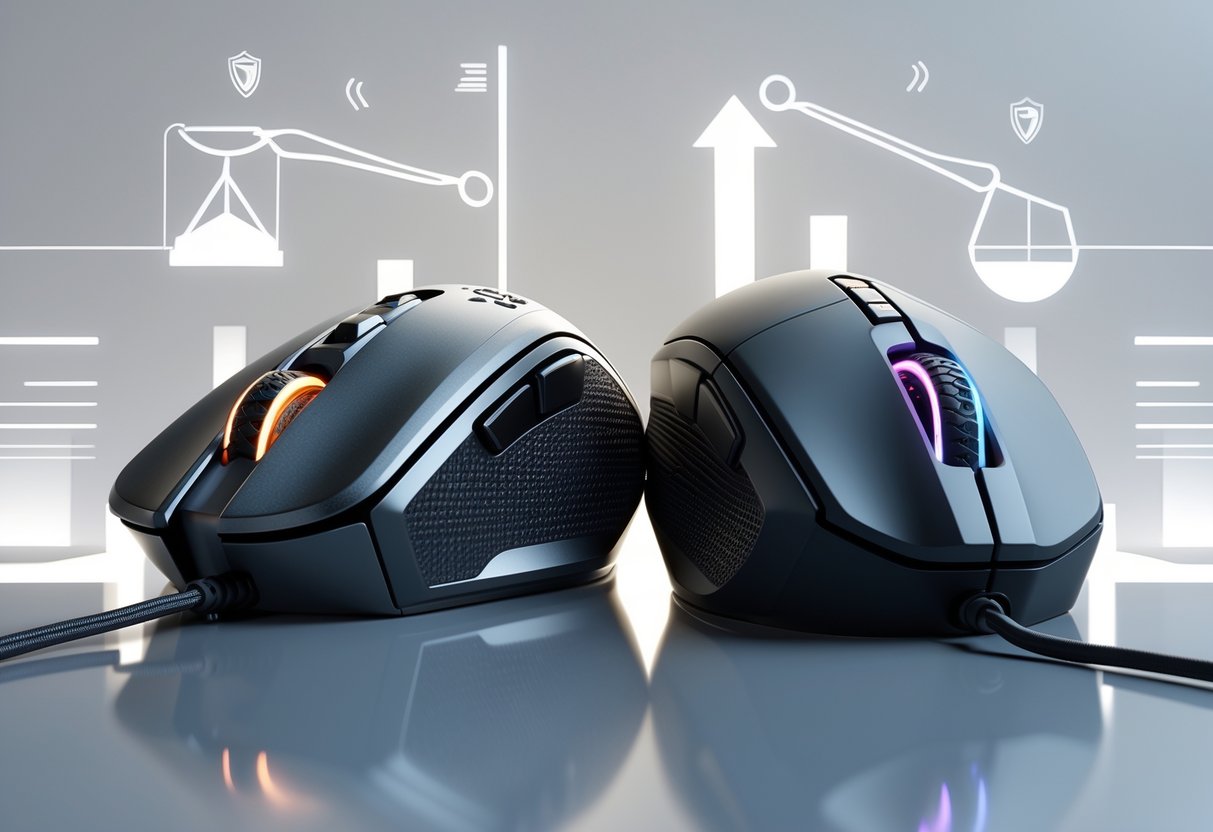
Mouse weight shapes how companies design and build them. Lighter mice push engineers to get creative with materials, while heavier ones usually stick to tried-and-true methods.
Long-Term Use of Lightweight Mice
Lightweight mice face a few unique durability issues. Manufacturers cut out material wherever they can, so every remaining part has to do more work.
The shell matters a lot here. Many lightweight mice use honeycomb patterns or ultra-thin plastics, which can create weak spots over time.
Durability concerns you might notice:
- Shell flexing during intense play
- Buttons wearing out faster because there’s less support
- Cable strain since the body is lighter
That said, premium lightweight mice often surprise people. Companies like Logitech and Razer pour tons of effort into testing and materials. They use carbon fiber and aerospace-grade plastics.
Engineering makes all the difference. A well-built 60-gram mouse can last longer than a sloppy 120-gram one. Some pros actually use lightweight mice for thousands of hours without any major issues.
Warning: Steer clear of budget lightweight mice under £30. They usually cut corners on structure.
Heavier Mice and Construction Materials
Heavier mice usually stick to traditional building methods. Their extra weight comes from thick plastic shells, metal scroll wheels, and sometimes internal weights.
You’ll find robust materials throughout. Thicker shells mean less flex and fewer cracks. Metal parts like scroll wheels and side buttons usually outlast plastic ones.
Why some gamers like heavier mice:
- Buttons are less likely to wobble
- Thicker cables don’t kink as easily
- They just feel solid during fast movements
But there’s a trade-off. Heavier mice sometimes use cheaper, dense plastics instead of fancy lightweight stuff. That doesn’t always mean they’re lower quality, though.
Some brands add weight on purpose with metal plates or adjustable systems. This lets you tweak the feel but still keeps the mouse sturdy.
A lot of pros prefer the heft of a heavier mouse for reliability. That extra material can give you confidence when it counts.
Frequently Asked Questions
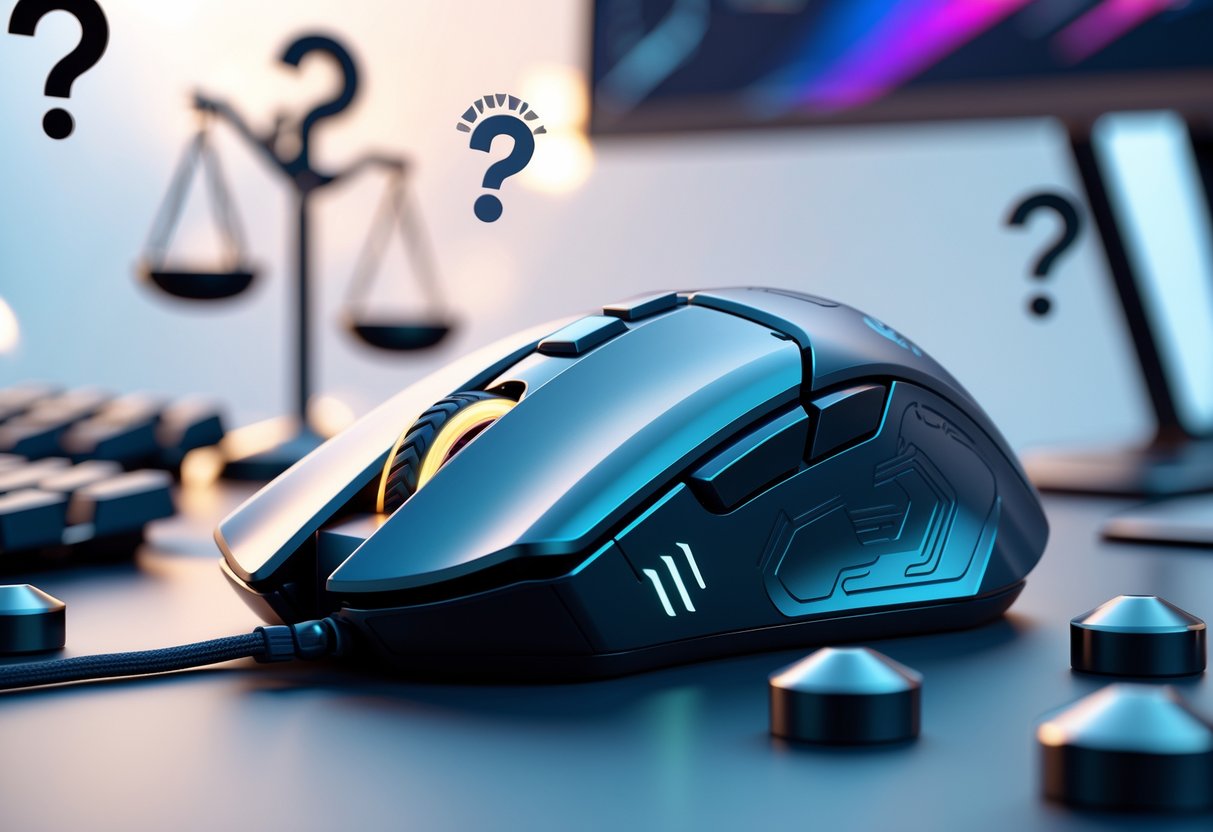
Picking a gaming mouse? Weight plays a big role in both performance and comfort. People have plenty of questions about ideal weights, adjustable features, and how weight shapes gameplay across genres.
What factors should be considered when choosing the weight of a gaming mouse?
Your grip style matters most. Palm grip fans usually go for heavier mice (100-120g) for that stable feel. Claw and fingertip grips work better with lighter mice (60-80g) for fast movement.
Think about what games you play. Strategy titles and design work benefit from heavier mice for control. Shooters and MOBAs? Lighter mice help with quick aiming.
Hand size also comes into play. Big hands can handle heavier mice more easily. Smaller hands might find weight distribution awkward during long sessions.
How does the weight of a gaming mouse affect gaming performance?
Mouse weight changes your reaction time and accuracy. Lighter mice (under 80g) let you flick and switch directions faster in competitive games.
Heavier mice (over 100g) give you steadier tracking for slow, precise moves. That added weight helps cut down on accidental slips and gives you tighter aim.
Gaming expert James Connolly says, “most professional FPS players now use mice under 70g for the speed advantage, whilst RTS players often stick with heavier options for precision.”
Your muscle memory will adjust to whatever you use most. Sudden changes can throw you off until you get used to the new weight.
Can you recommend some lightweight gaming mice that are popular among gamers?
The Logitech G Pro X Superlight weighs just 63g and remains a favorite for many pro players. It’s got solid build quality for such a light mouse.
Razer Viper Ultimate is 74g and wireless. People like its ambidextrous shape and dependable performance.
If you’re on a budget, the Glorious Model O comes in at 67g and costs less than most high-end models. Its honeycomb shell keeps the weight down but stays pretty durable.
What are the pros and cons of using a heavy gaming mouse?
Heavy mice shine when it comes to stability and control. They don’t move accidentally during heated moments and track consistently for detail work.
The weight helps you build reliable muscle memory. Over time, your movements get more predictable.
But heavy mice can tire out your hand faster in long sessions. They’re also slower for quick movements in fast-paced shooters.
Some people find heavy mice a pain to carry for LAN events or travel. You’ll definitely notice the extra weight when packing your gear.
Why do some gamers prefer adjustable weights in their gaming mice?
Adjustable weight systems let you tweak your mouse for different games or moods. Maybe you want more heft for strategy games, but less for shooters.
Popular models like the Logitech G502 let you adjust from 121g to 139g with removable weights. That kind of flexibility appeals to gamers who switch genres a lot.
Weight distribution can matter as much as total weight. Some mice let you place weights in specific spots to balance things out for your grip.
You can also use these systems to slowly get used to lighter or heavier setups. Just take out a bit of weight at a time instead of making a big jump.
Is there an ideal weight for a gaming mouse that suits most players?
Most gaming mice usually weigh somewhere between 70g and 120g.
People tend to find that sweet spot around 80-90g for general use. That range gives you decent speed, but you don’t lose too much control either.
These days, lighter mice are all the rage. You’ll see a lot of new models aiming for under 80g.
Honestly, pro esports players started that trend—they want every millisecond of speed they can get.
Still, the “ideal” weight? It really comes down to your own preferences and gaming habits.
What works for pros might not feel right for someone who just games on weekends.
Aaron Connolly, who knows a thing or two about gaming gear, recommends trying out different weights at gaming cafés or borrowing a friend’s mouse before dropping cash on something new.
And here’s the thing: your ideal weight might even change as you get better at gaming.
A lot of people start out with heavier mice, but as their skills improve, they usually gravitate toward lighter ones.

